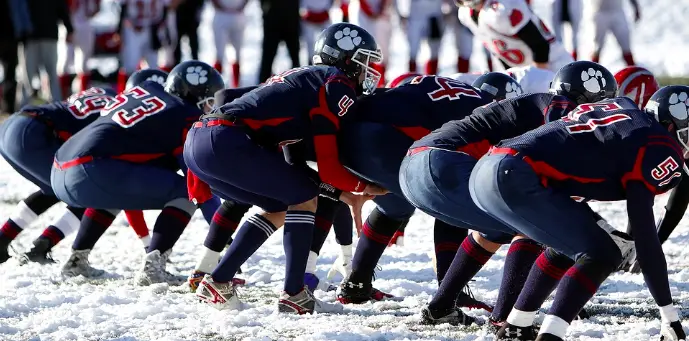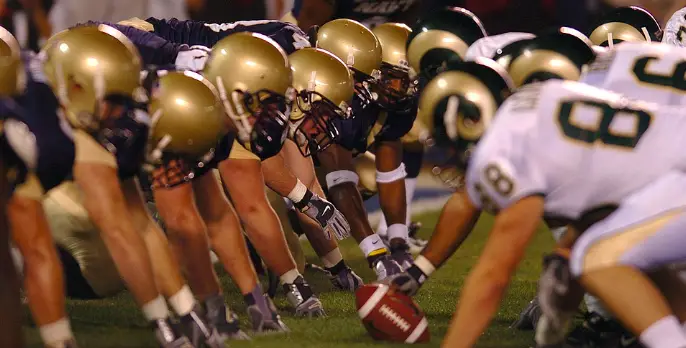A false start in football occurs when an offensive player who is set for the play moves in a way that simulates that the play is starting prior to the ball being snapped.
The official NFL rule on false starts in football is as follows:
It is a False Start if the ball has been placed ready for play, and, prior to the snap, an
offensive player who has assumed a set position charges or moves in such a way as to simulate the start of a play, or if an offensive player who is in motion makes a sudden movement toward the line of scrimmage.Any quick abrupt movement by a single offensive player, or by several offensive players in unison, which simulates the start of the snap, is a false start
– NFL Rulebook
As you can see from the definition above the general idea behind false start penalties is that they will be called when a player moves in a way that would make his opponents think the play is starting.
The penalty for a false start in the NFL is five yards. A false start penalty is a dead ball foul meaning that it takes place before the play starts. This means that if this penalty is called the play will immediately be blown dead.

For football fans it can be tough to determine what movement is going to cause their team to be given a false start penalty.
Unfortunately for players set in their positions on the line of scrimmage a small flinch is enough to cause this penalty. If an offensive lineman flinches or even raises a foot this is enough to have this penalty called.
Exceptions – QBs Under Center Can Look Around

Though false start penalties can be called based off almost any movement there are a few exceptions built into the rule that will not be called.
If a quarterback is under center he is able to turn his head in shoulders in order to scan the field. Under center would mean that a player, usually the quarterback is crouched right behind the center ready to snap the ball.
In this position the quarterback is still allowed to look around to read the defense before the snap. This exception is put into place because otherwise, quarterbacks would not be able to get a pre-snap read while under center.
If a guard or tackle attempted to turn their head or shoulders after getting set in position they would earn themselves a false start penalty.
What About Players In Motion?
One aspect of the false start penalty that can be confusing is the players moving in the backfield. If you’ve watched football before you have likely noticed that some plays feature players running before the play even starts.
There are two reasons that a player in motion in the backfield does not get this penalty. First, the offense is allowed to have a single player in motion as a play starts. Second, that player must not be travelling towards the line of scrimmage.
In other words, one player can move in the backfield but he must be moving laterally or backwards.
Since this player is not moving towards the line of scrimmage he is not simulating that the ball is being snapped.
A player in motion will almost never cause a defensive player to jump across the line of scrimmage because he believes the play has started.
If a player in motion starts to travel towards the line of scrimmage he will earn himself a false start or an illegal motion penalty.
How Does A Quarterback Get A False Start?
Though not always the case quarterbacks tend to get false start penalties when trying to get the defense to jump offside.
Quarterbacks are able to use a hardcount to trick their opponents but if the QB resorts to bobbing his head or moving around too much he is going to earn himself a false start penalty.
On the odd occasion, a quarterback may earn a false start penalty if they are moving around too exuberantly while trying to get their offensive lineman to snap the ball in a hurry.
Though in most cases this would be let go as it is not influencing the opponents into thinking the play has started. Instead, the quarterback is simply trying to get his lineman’s attention so he will snap the ball.
What is the difference between false start and offside?

The main difference between offsides and false starts in football is that one of these penalties is assessed to the offense while the other is assessed to the defense.
An NFL false start is a penalty that is going to be given to the offense. This penalty occurs when an offensive players move before the play starts.
Offside on the other hand occurs when a defensive player is on the wrong of the ball when the ball is snapped.
Instead of simply moving before the snap this penalty is only called when the player is lined up over the line of scrimmage or moves across the line of scrimmage early.
Though there are actually several penalties that can be called when defensive players start a play early.
An encroachment penalty occurs when a player is offside then touches an opponent or has an unimpeded path to the quarterback.
A neutral zone infraction occurs when a player enters the neutral zone causing an offensive player to react. And as we covered earlier offside is called when a player is on the wrong side of the line of scrimmage when the ball is snapped.
These three penalties of offside, encroachment, and neutral zone infraction are essentially the defensive equivalent of a false start penalty.
That is all on false starts in football learn about delay of game penalties or penalties for illegal formations to get a better understanding of the rules of football.

